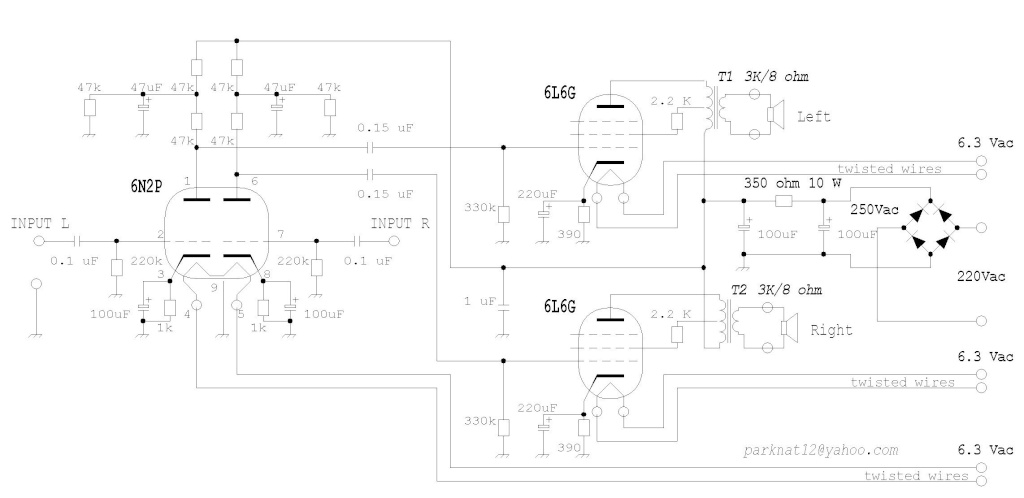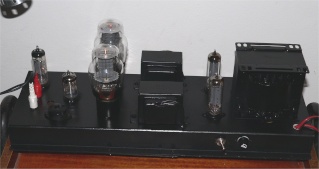Stereo class A Ultralinear 6+6W - 2x 6L6G + 1x 6N2P
Schematic:

Line transformer output = 250 Vac 0.3A - 6.3 Vac 3A
Diode bridge = 4 x 1N4007
Filter Cap = 2 x 100 uF 385 V
Plate voltage of 6L6G = 290 Vcc (plate <> cathode)
Grid #2 voltage of 6L6G = 240 Vcc (grid2 <> cathode)
Bias current of 6L6G = 44 mA (17.2 V @ 390 ohm 2W self bias resistor)
Audio output transformers = 3Kohm/8ohm, Grid #2 connection @ 43% of primary winding (ultralinear).
note:
6N2P =6AX7 = ECC41 = 6h2n
6N2P, 6N2PEV (6H2n, 6H2n-EB)
You can try out 6N1P = ECC88 instead of 6N2P (with less gain)
6N1P, 6N1PVI, 6N1PEV (6H1n, 6H1nBN, 6H1nEB)
6L6 = 6L6G = 6L6GT
http://hvid.it/datasheets/6L6 RCA.pdf

Youtube video:
Stereo Hi-Fi Tube amplifier 6L6G - YouTube
Schematic:

Line transformer output = 250 Vac 0.3A - 6.3 Vac 3A
Diode bridge = 4 x 1N4007
Filter Cap = 2 x 100 uF 385 V
Plate voltage of 6L6G = 290 Vcc (plate <> cathode)
Grid #2 voltage of 6L6G = 240 Vcc (grid2 <> cathode)
Bias current of 6L6G = 44 mA (17.2 V @ 390 ohm 2W self bias resistor)
Audio output transformers = 3Kohm/8ohm, Grid #2 connection @ 43% of primary winding (ultralinear).
note:
6N2P =6AX7 = ECC41 = 6h2n
6N2P, 6N2PEV (6H2n, 6H2n-EB)
You can try out 6N1P = ECC88 instead of 6N2P (with less gain)
6N1P, 6N1PVI, 6N1PEV (6H1n, 6H1nBN, 6H1nEB)
6L6 = 6L6G = 6L6GT
http://hvid.it/datasheets/6L6 RCA.pdf

Youtube video:
Stereo Hi-Fi Tube amplifier 6L6G - YouTube
Last edited:
Simple doesn't mean bad or incomplete 🙂.
Less components you use, less trouble you'll get.
There is no need for gridstoppers in this particular circuit, but you can use 1 Kohm resistors for that.
Less components you use, less trouble you'll get.
There is no need for gridstoppers in this particular circuit, but you can use 1 Kohm resistors for that.
If you can be sure the source does not place a DC offset on the inputs you could even remove the input caps.
Never use them myself, haven't lost a tube or amp yet.. (40 + yrs)
Never used what ? 🙂
Gridstoppers or input caps?
Input Caps. They block DC from upsetting the bias on a stage. It wont destroy your input stage as it is current limited by the anode resistor.
An example of a stage that could result in anode over-dissipation would be a choke loaded input stage. If a DC bias shift occurred, the DC resistance of the choke might not be enough to limit the anode current. This could result in destruction of the tube due to excessive anode dissipation.
Grid-stop resistors help prevent pickup of RFI from radio stations, TV, etc but this is not a potential damaging source for the tube or circuit. Only causes distortion.
An example of a stage that could result in anode over-dissipation would be a choke loaded input stage. If a DC bias shift occurred, the DC resistance of the choke might not be enough to limit the anode current. This could result in destruction of the tube due to excessive anode dissipation.
Grid-stop resistors help prevent pickup of RFI from radio stations, TV, etc but this is not a potential damaging source for the tube or circuit. Only causes distortion.
What about a short circuit on the driver between anode and grid?
It could inject High Voltage on the preamplifier output stage, I suppose. 😱
It could inject High Voltage on the preamplifier output stage, I suppose. 😱
What the Gimp says as I was corroborating his comment.. 😀
(No input caps, but I do use grid stoppers religiously, perhaps too religiously in some instances.)
(No input caps, but I do use grid stoppers religiously, perhaps too religiously in some instances.)
What about a short circuit on the driver between anode and grid?
It could inject High Voltage on the preamplifier output stage, I suppose. 😱
The source impedance is usually quite high in the event of a grid to plate short except in the case of IT or choke coupling where some serious mischief could occur. I've never seen a grid to plate short in any small signal triode or pentode to date - this does not mean it can't happen. The transformer coupled output circuitry in my line stage cannot be damaged by quite large voltages as long as the current is limited (it is) - if you are using solid state gear I would recommend fitting a higher voltage output cap - this will take care of the issue without requiring an additional part in the signal path.
You can try out 6N1P = ECC88 instead of 6N2P (with less gain)
6N1P, 6N1PVI, 6N1PEV (6H1n, 6H1nBN, 6H1nEB)
No way is a 6N1P equivalent to an ECC88 despite a lot of people saying it is. I have made extensive measurements and I can confirm they are not equivalent. However, the 6N23P IS a close equivalent to the ECC88.
Cheers
Ian
No way is a 6N1P equivalent to an ECC88 despite a lot of people saying it is. I have made extensive measurements and I can confirm they are not equivalent. However, the 6N23P IS a close equivalent to the ECC88.
Cheers
Ian
Thanks, good point!
I think I have a quibble, but I hope it's unfounded.
The 6N2P is very similar to a 12AX7, but with a 6.3V heater, correct?
If so, isn't a 47k anode resistor way too low of a value for low distortion? The datasheet gives mu = 100, gm = 2.1mA/V. Knowing that, the 6N2P anode resistance would be in the vicinity of 50k, no? If that's right, then the anode resistors should be at least 100k ohms, if I'm not mistaken. (Which I could be!)
--
The 6N2P is very similar to a 12AX7, but with a 6.3V heater, correct?
If so, isn't a 47k anode resistor way too low of a value for low distortion? The datasheet gives mu = 100, gm = 2.1mA/V. Knowing that, the 6N2P anode resistance would be in the vicinity of 50k, no? If that's right, then the anode resistors should be at least 100k ohms, if I'm not mistaken. (Which I could be!)
--
I think I have a quibble, but I hope it's unfounded.
The 6N2P is very similar to a 12AX7, but with a 6.3V heater, correct?
If so, isn't a 47k anode resistor way too low of a value for low distortion? The datasheet gives mu = 100, gm = 2.1mA/V. Knowing that, the 6N2P anode resistance would be in the vicinity of 50k, no? If that's right, then the anode resistors should be at least 100k ohms, if I'm not mistaken. (Which I could be!)
--
That is correct. My guess was that there was too much gain with a 100K anode resistor in this circuit. (and no global feedback). For example Abdellah circuit uses 6N1P in this place, it has a lower gain.
OK, I see.
First, a UL (distributed load) output stage will still make more THD than a triode output stage, and I would think you'd want some negative feedback (NFB) around it to make it sound acceptable.
Therefore, the "excess" gain from the 6N1P with 100k plate resistor could be put to good use as global NFB, from the output transformer output to the cathode of the 6N1P.
Or maybe use local plate feedback around the 6L6 instead?
--
First, a UL (distributed load) output stage will still make more THD than a triode output stage, and I would think you'd want some negative feedback (NFB) around it to make it sound acceptable.
Therefore, the "excess" gain from the 6N1P with 100k plate resistor could be put to good use as global NFB, from the output transformer output to the cathode of the 6N1P.
Or maybe use local plate feedback around the 6L6 instead?
--
OK, I see.
First, a UL (distributed load) output stage will still make more THD than a triode output stage, and I would think you'd want some negative feedback (NFB) around it to make it sound acceptable.
Therefore, the "excess" gain from the 6N1P with 100k plate resistor could be put to good use as global NFB, from the output transformer output to the cathode of the 6N1P.
Or maybe use local plate feedback around the 6L6 instead?
--
Onestly I don't like negative feedback sound 😡, it seems too "flat" for my hears 🙂.
I prefere having no feedback at all, but this is just a personal opinion.
With 100K plate the gain of 6N2P is too high.
The 100u cathode cap will short the feedback to ground.
You're right, I forgot a resistor 🙁.
I will post the correct schematic soon.
Thank you 🙂
This is the final version with grid-stoppers and feedback:

Υou also forgot to make the anode resistors 100K. With feedback, you are going to need the gain.
- Status
- Not open for further replies.
- Home
- Amplifiers
- Tubes / Valves
- Stereo class A 6+6W - 2x 6L6G 1 x 6N2P